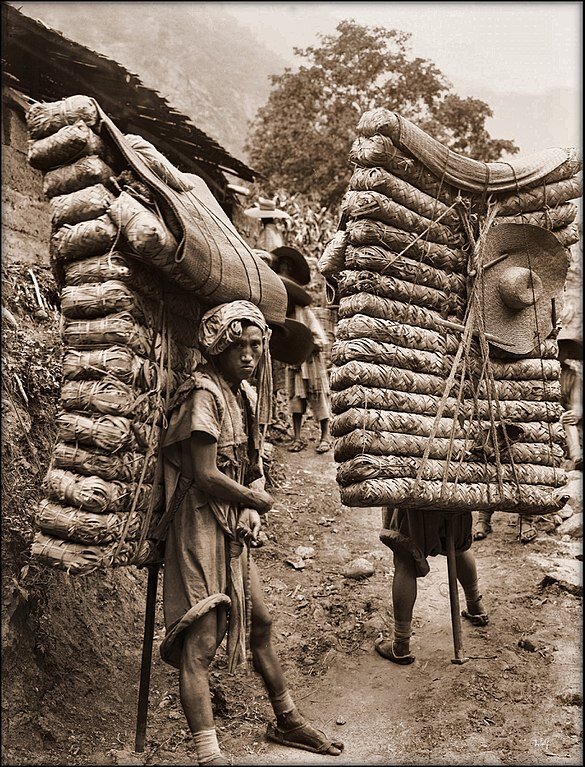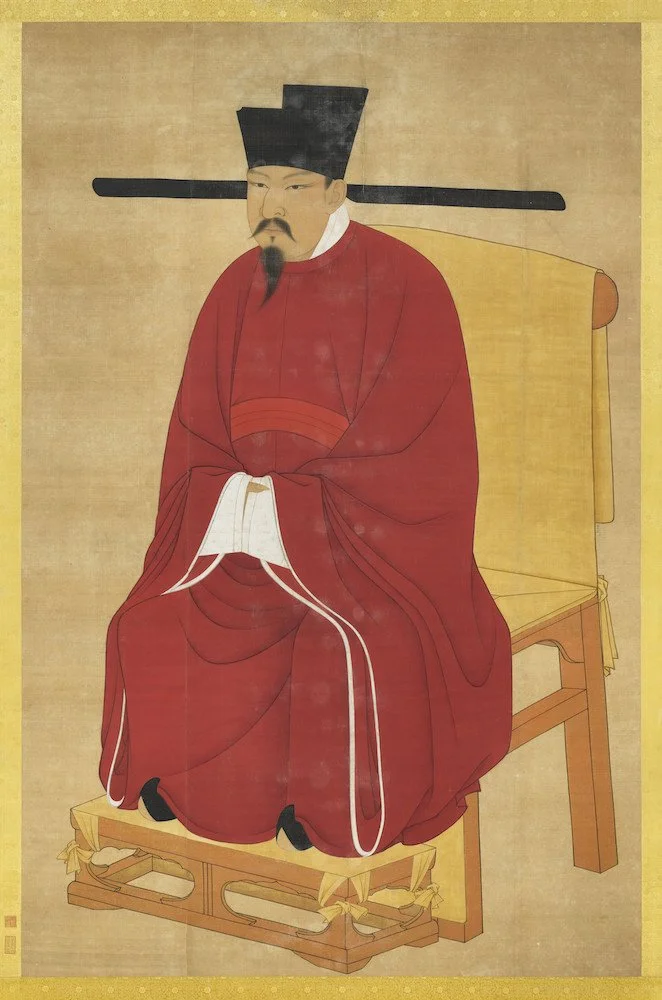Ancient Tea Horse Road
Men laden with 'Brick Tea' for Thibet (Tibet) in 1908 by photographer Ernest H. Wilson creative commons license
I think one of the coolest things about Pu'er tea is that it is a Chinese tea that is steeped in such a unique adventure and travel history.
Exploring the Ancient Tea Horse Road 茶马古道(cha ma gu dao) or རྒྱ་ལམ།Gyalam in Tibetan a now extinct but over 1000 year old trading route, we will illuminate the exciting adventure and travel elements of Pu'er tea’s long history.
To be more specific a 2,250 km/1400 mile long trading route that winds along the treacherous mountain passes in Southwest China,on the Tibetan plateau, and near the Himalayas.
a great interactive map designed by some people at StoryMaps
The Tea Horse Road connected brick tea from Sichuan and pu'er tea from Yunnan, to Tibet after a three to six month long overland journey where tea was traded for Tibetan horses.
Historic and Legendary Origins
The history of the Tea and Horse Road can be traced to the era of the Tang Dynasty 618-907 CE in China and Tubo Period 7th-9th century CE in Tibet
Court Ladies Playing Double Sixes. Attributed to Zhou Fang. 8th century, Freer Gallery of Art. Ink and color on silk
“The two wives of the first king of Tibet, Songtsen Gampo, were understood to be emanations of Tara; the princess from Nepal is identified with White Tara and the Chinese princess with Green Tara”
White Tara and Green Tara, The Metropolitan Museum of Art, Zimmerman Family Collection, Purchase, Oscar L. Tang Gift, in honor of Agnes Hsu, 2012
Legend has it, tea was first brought to Tibet, when Tang dynasty Chinese Princess Wen Cheng 文成 རྒྱ་བཟའ་ཀོང་ཇོ། married Tibetan King Songtsen Gampo in 641CE.
King Songsten Gampo, private collection.
Allegdly some tea traveled with Princess Wen Cheng as part of her dowry.
Most scholars think tea was introduce into Tibet more informally be merchants earlier or around the same time.
detail of Wen Cheng རྒྱ་བཟའ་ཀོང་ཇོ། from painting above. Her Tibetan name translates literallly to: Chinese Wife.
Tibetans Loved Chinese Tea and The Chinese Needed Tibetan Horses
First introduced to the nobility and elite of Tibet, tea quickly became a staple of the Tibetan diet in all sectors of society.
Night-Shining White, Han Gan, ca 750, The Metropolitan Museum of Art, Purchase, The Dillon Fund Gift, 1977
Trade between Tibet and China began to flourish when the Chinese military discovered they desperately needed horses to match nomadic forces. Tibetans highly valued tea which according to the BBC, made
“raw tea at the time worth more than porcelain or silk. The exchange? A single horse for 60kg of tea.”
Song Dynasty Emperor Shenzhong 宋神宗, National Palace Museum Taiwan.
The Chinese Song Dynasty court established the 茶马司chamasi, Tea and Horse Office, to oversee and regulate the tea and horse trade in1074 CE.
The rate set by the Tea and Horse Office was 130 pounds of tea for a single horse.
According to National Geographic:
“By the 13th century China was trading millions of pounds of tea for some 25,000 horses a year. …bartering tea for horses continued through the Ming dynasty (1368-1644) and into the middle of the Qing dynasty (1645-1912).
map of the Ming Empire reflecting the political situation in 1389 CE
Heydey of the Tea Horse Trade (and Decline)
Hunting on Horses, c.1600s-1700s, Cleveland Museum of Art, Gift of the John Huntington Art and Polytechnic Trust 1915.680
The heydey of the tea and horse trade between Yunnan, Sichuan, and Tibet was during the Ming Dynasty (1369-1644).
China’s need for horses began to wane in the 18th century, however, and the Chinese Qing Dynasty court stopped buying horses from Tibet in 1735.
Wangchuan Villa, Wang Yuanqi, 1711, The Metropolitan Museum of Art, Ex coll.: C. C. Wang Family, Purchase, Douglas Dillon Gift, 1977
The tea trade continued along the Tea Horse Road though. Tea was now traded for other goods according to National Geographic:
“hides from the high plains, wool, gold, and silver, and, most important, traditional Chinese medicinals that thrived only in Tibet.
”
Illustrations of Tibetan Materia Medica, from the Wellcome Collection.
The Tea and Horse Market in Yunnan
Even though the brick tea for horses trade started in Sichuan, In 1661, the fifth Dalai Lama asked the Qing court to set up a large market for the tea and horse trade in Beisheng which is present day Yongsheng, Yunnan.
The Fifth Dalai Lama, The Asian Art Museum, ransfer from the Fine Arts Museums of San Francisco, Gift of Carlotta Mabury.
After the establishment of the market in Yunnan, there was an increase in the amount of tea from Yunnan transported to Tibet along the Tea and Horse Road.
Even though the tea road between Sichuan and Tibet is older and historically a more important trade route, the one in Yunnan is how Pu’er tea came to be traded on the Ancient Tea Horse Road.
AKA: The Southern Silk Road
Considering the thriving commercial and cultural trade that occurred along the Ancient Tea Horse Road is also sometimes referred to as the Southern Silk Road. As with all trade routes, the most valuable interactions are the exchange of ideas from person to person across cultures.
Often the people engaging in this exchange were tea porters or muleteers who would carry more than their own weight in tea on their back (see photo above)!
Since I’m always interested in politics, power, and how they are often shaped by everyday consumer treasures like tea, I’m fascinated with this tidbit from National Geographic about how tea shaped ancient power structures:
“Just as China’s imperial government used to regulate the tea trade in Sichuan, so monasteries influenced the trade in theocratic Tibet. The Tea Horse Road, known to Tibetans as the Gyalam, connected the important monasteries. Over the centuries, power struggles in Tibet and China changed the Gyalam’s route.”
Ancient Tea Horse Road at Chenyao Cliff in 2017 creative commons license
For Further Exploration
Adventure, exploration, travel, trade, political intrigue, prized tea…what more could you ask for?
When you drink your Pu'er Tea you can let your imagination wander around this adventurous trade route and soak up the history of the Ancient Tea Horse Road with each sip.
For more in depth reading check-out:
National Geographic’s Feature on the Ancient Tea Horse Road
The Silk Road Foundation’s piece on the Ancient Tea Horse Road
China Heritage Quarterly on the Ancient Tea Horse Road



















